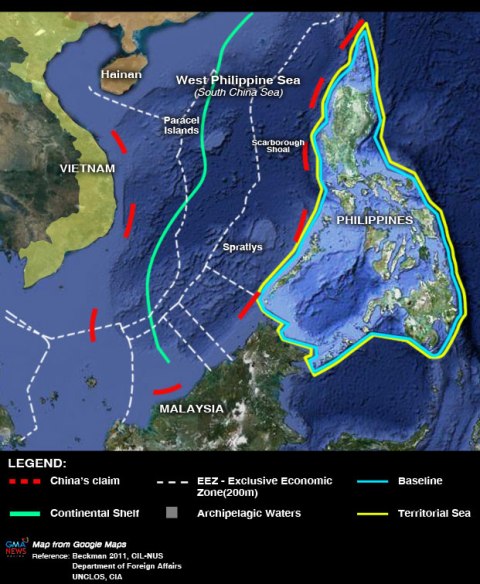After two weeks, there is still no end in sight to the standoff between Philippine and Chinese vessels at the Panatag (Scarborough) Shoal. Located west of Masinloc in Zambales province, the resource-rich cluster of reefs and islets is within the territorial limits of the Philippines, but China has also laid historical claim to the area. GMA News Online has prepared the primer below, which explains some of the most frequently used terms by officials, to help readers navigate the jargon-laden statements from both sides of the continuing conflict in the west Philippine Sea. What is the UNCLOS? The United Nations Convention on the Law of the Sea (UNCLOS), also known as the Law of the Sea Treaty, is the international agreement that defined the limits of the territorial seas of nations and the areas in which they could exploit marine resources. It also established the rules for the use of the high seas for international navigation, and outlined the rights and responsibilities of nations in the protection of the marine environment. What was the rationale for UNCLOS? In the past, the three-mile rule was traditionally used by coastal states to determine the limits of their territorial waters. After World War II, however, states began extending their control beyond previous limits. In 1945, due to domestic oil demands, the United States claimed the right to harvest the natural resources in its continental shelf. Chile, Peru, and Ecuador asserted sovereign rights over a 200-mile zone, hoping to limit the access of foreign fishing fleets and prevent the depletion of fish stocks in their adjacent seas. Egypt, Ethiopia, Saudi Arabia, Libya, Venezuela, and some Eastern European countries claimed 12 miles as part of their territorial seas. Meanwhile, archipelagic nations such as Indonesia and the Philippines asserted the right to dominion over the waters that separated their islands. Because of this multitude of claims and counterclaims, the UNCLOS became necessary to resolve conflicts among countries over the seas adjacent to their coasts. When did the agreement come into force? After eight years of negotiations, the convention concluded in 1982 and came into force as a binding treaty in 1994. Who are the members of UNCLOS? As of June 2011, the Convention had 162 signatories. The Philippines signed it on May 8, 1984, while China signed it on June 7, 1996.

What are the main provisions of the treaty? The UNCLOS provides for the following:
Baseline – Determined by connecting points on the coastline from a large map, this is the starting point for measuring the maritime territory of a coastal state.
Territorial sea – This is the belt of sea 12 nautical miles from the baseline. In this area, the coastal state exercises sovereign rights and may arrest foreign ships.
Contiguous Zone – This is the maritime area not exceeding 24 nautical miles from the baselines. The coastal state exercises authority over this area to the extent necessary to prevent infringement of its customs, fiscal, immigration, or sanitation authority over its territorial waters. This is a response to the practice of foreign ships lingering beyond a state’s territorial sea, and thus beyond its criminal jurisdiction, where they commit acts inimical to the coastal state.
Exclusive Economic Zone or EEZ – This is the maritime area within 200 nautical miles from a country’s baseline. Within the EEZ, the coastal state has rights over the economic resources of the sea, seabed, and subsoil to the exclusion of other states. However, other nations have the right of navigation and overflight over this area, subject to the regulation of the coastal state.
Continental Shelf – This is the seabed and subsoil of the submarine areas adjacent to the coastal state but outside the territorial sea. The continental shelf extends 200 nautical miles, and in some cases may extend up to 350 miles, following the natural prolongation of the soil. The coastal state has the right to explore and exploit the natural resources in this area, but this right does not extend to other materials such as shipwrecks.
What are the penalties for failure to comply with the provisions of UNCLOS? In case of disputes, states are mandated to settle their dispute by peaceful means. This may be done through an arbitration procedure of their choice. If no settlement is reached through an arbiter, they can bring the case to the ITLOS, the International Court of Justice (the tribunal of the United Nations), or a special tribunal. These tribunals mete out the penalties, which may be in the form of payment of reparations.
What is the ITLOS? The International Tribunal on the Law of the Sea is the court created under UNCLOS to settle disputes between states. These include matters regarding the interpretation or application of the Convention, and other issues that may be submitted to it for adjudication by the parties. It also has the power to issue advisory opinions. The Tribunal has 21 judges from various states and is based in Hamburg, Germany.
Has the ITLOS resolved any case so far? To date, 19 cases have been submitted to the Tribunal. Two cases are pending before the Tribunal. One of the cases handled by the ITLOS was the complaint from New Zealand and Australia regarding Japan’s experimental fishing program, which they said resulted in the overfishing of Bluefin Tuna. ITLOS provisionally ordered the parties to keep catches to the level they had agreed on, and to refrain from conducting fishing programs.
- YA/GMA News References & relevant links: UNCLOS and EEZ ITLOS UNCLOS membership History of UNCLOS 




